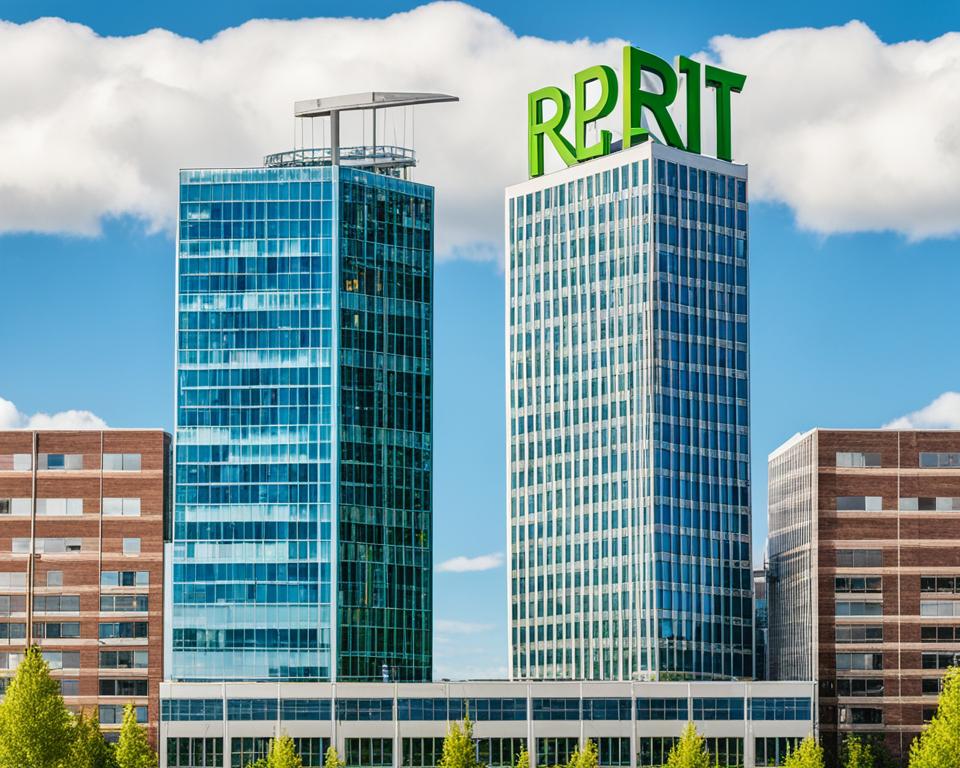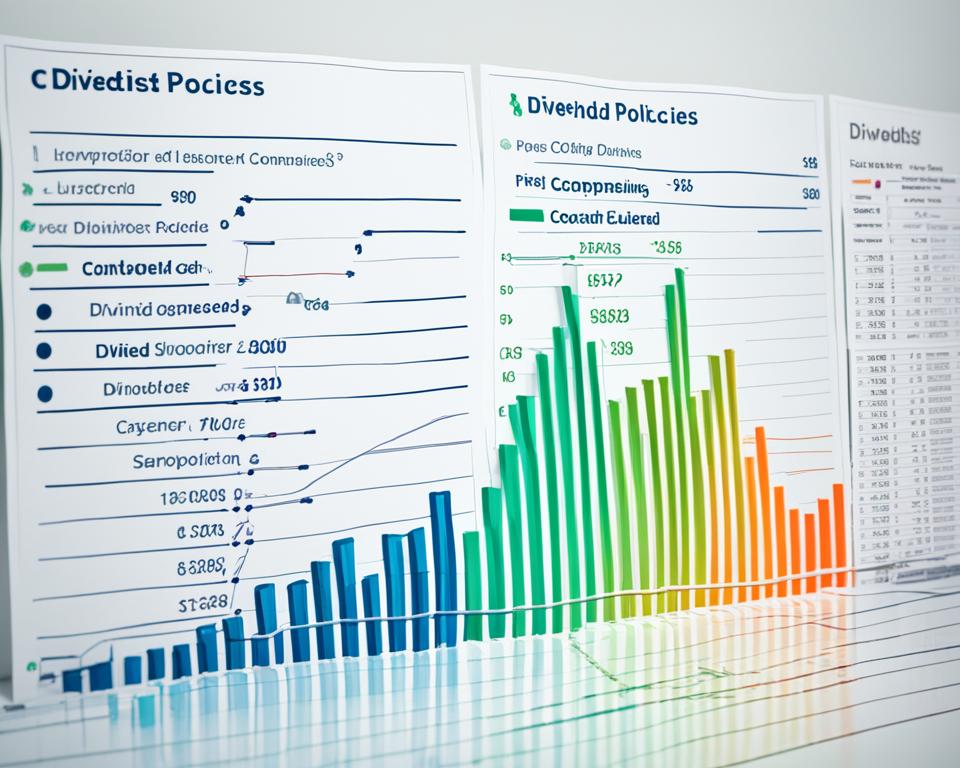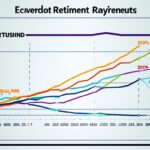As you navigate the vibrant landscape of the stock market, understanding the dividend policies of newly-listed companies is essential. Whether you’re a seasoned investor or new to the game, dividends are a vital source of income, with a significant portion of the S&P 500 dividend payers shaping your portfolio’s performance. When companies embark on the journey of an initial public offering (IPO), the SEC dividend disclosure requirements become a critical checkpoint, informing you of the potential investor income sources and advising you on the corporate dividend decisions ahead.
With the IPO market growth often signaling the entry of ambitious companies aiming to reshape their respective industries, their stance on dividend payout plans can be indicative of their future financial strategies. Through meticulous examination of a company’s registration documents, you gain insights into the long-term profitability and health of an organization. Let’s delve into the world of newly-minted stocks and unpack the dividend disclosures that could sway your investment decisions.
Key Takeaways
- The importance of dividend policies as a decision-making factor for investors.
- An overview of the SEC’s role in mandating transparency regarding dividend disclosures in IPO filings.
- Insights into why many newly-listed companies prioritize growth over initiating dividend payouts immediately post-IPO.
- The reasons a minority of IPOs may diverge from the norm by offering dividends to attract shareholders.
- Understanding Airbnb and DoorDash’s approach to dividends and how it reflects their broader corporate strategies.
- An introduction to the dynamics of IPO market growth and how it correlates with companies’ dividend decisions.
The Significance of Dividend Policies in Investment Decisions
Delving into the dynamic arena of equity investments, you—as an investor—must weigh the dividend policies of newly-listed companies with the intent not just to boost your income streams but to ensure a solid growth trajectory for your assets. When companies recently enter the public domain, the implications of their dividend policies serve as a clear signal of their future financial strategies and operational maturity. Thus, the careful scrutiny of these policies is more than due diligence; it’s a proactive approach to safeguarding your investments against market volatility.
Investors’ Perspective on Dividends
For you, dividends might represent a regular income that indicates a company’s enduring profitability and reliability. Particularly, within the context of dividend payout ratios and the impact of dividends on stock prices, these regular payments can offer stability in a sea of market fluctuations. Investors often lean towards entities that not only promise growth but also value shareholder returns, with dividend yields playing a pivotal role in their investment decisions.
SEC Mandates on Dividend Disclosures
The SEC leaves no stone unturned in upholding transparency, especially when it involves informing shareholders about the ramifications of dividend policy implications. As such, the mandatory disclosures set by the SEC offer you a window into a company’s financial soul. These insights inform your decision-making, offering you not just data, but context on how newly-listed companies plan to allocate their profits—whether it’s towards rewarding investors with dividends or reinvesting into promising growth avenues.
Dividend Policy’s Role in Attracting Shareholders
Are dividends the golden tickets for companies seeking to lure investors? Perhaps. A new market entrant’s announcement of a potential dividend payout can be a powerful magnet for you if your strategy is centered around earning immediate returns. Conversely, the promise to reinvest initial profits for future growth may attract those with a longer investment horizon. This juggling act between immediate shareholder rewards and long-term capital growth encapsulates the decisive role of dividend policies of newly-listed companies.
- Dividend payments influence stock attractiveness and can indicate a company’s financial vitality.
- A higher dividend payout ratio represents a generous shareholder return policy but may affect cash flow and reinvestment potential.
- The presence of dividends can optimistically sway stock prices, implicitly factoring into the company’s market valuation.
Understanding SEC Dividend Disclosure Requirements
As you explore investment opportunities in newly-listed companies, it’s paramount to grasp the nuances of SEC dividend disclosure mandates. These regulatory requisites are instrumental in shaping your understanding of a company’s approach to sharing profits through dividends. By scrutinizing these dividend policy determinants, you equip yourself with the foresight needed to make informed decisions that align with your investment goals.
17 CFR § 229.201 Explanation
In adhering to the guidelines stipulated in 17 CFR § 229.201, companies undertake the responsibility of presenting a transparent account of both their historical and prospective dividend policies. This regulation serves as a critical component of corporate dividend decisions, particularly for those companies that set their sights on the vibrant public domain through an IPO. It is in this regard that companies must provide detailed descriptions outlining their prior dividend distributions and elucidate their future dividend plans within their SEC filings.
IPO Filing Requirements and Implications
A company’s initial leap into the stock market requires compliance with IPO filing requirements, where the disclosure of a dividend policy isn’t just a formality—it’s a fundamental investor consideration. Through the lens of this requirement, potential investors like you assess a company’s growth prospects and its stance on profit-sharing. This disclosure ultimately influences how the market receives a company post-IPO, with an unequivocal impact on the stock’s appeal.
Company Statements on Future Dividend Intentions
Statements articulating future dividend intentions are more than simple declarations; they are a testament to a company’s financial strategy and operational health. When firms, brimming with earning potential, assert their intentions to not distribute dividends, they bring to light a deliberate choice to reinvest in future growth. Conversely, those expressing a commitment to continue or initiate dividends signal a readiness to reward shareholders. Such pronouncements are pivotal, guiding you as you gauge the balance between wanting immediate returns and investing in a company’s long-term value appreciation.
Common Dividend Policies within Newly-Listed Companies
As you explore the burgeoning IPO market growth, you’ll notice a trend among newly-listed companies: a prevalent preference not to offer dividends immediately. When a company goes public, its dividend payout ratio—that is, the percentage of earnings paid to shareholders as dividends—is often gauged by investors. In most cases, the ratio is minimal or non-existent. This strategic choice mirrors a broader dividend growth strategy, where businesses aim to maximize long-term shareholder value through reinvestment rather than short-term cash distribution. As a savvy investor, you’ll find that these strategies are laid out in companies’ S-1 filings, providing you with a snapshot of their financial roadmap.
While this approach might signal a delay in direct earnings from dividends, it reflects a focus on dividend yield management. Companies that steer clear of immediate dividend commitments often channel their resources into strategic reinvestment—be it R&D, market expansion, or enhancing operational efficiency. The intent is clear: to foster a solid foundation for future profitability, which may eventually lead to more robust and sustainable dividend policies down the line.
- Observing the IPO market growth, it’s apparent that companies vie for a competitive edge by opting to reinvest over disbursing dividends.
- In-depth analysis of S-1 disclosures unveils strategies that prioritize capital deployment for upcoming ventures and technological advancements.
Below is a table providing insight into the dividend payout practices of recently IPO’ed companies. You’ll notice a tendency towards capital conservation and growth investments within these first few critical market-engagement years.
| Company | S-1 Dividend Disclosure | Utilization of Capital |
|---|---|---|
| Company A | No immediate dividend; focus on growth | Expansion into new markets |
| Company B | Retaining earnings for future operations | Research and Development (R&D) |
| Company C | Future dividend possibility, based on performance | Operational scalability |
This conservative approach is echoed across boardrooms of newly-listed entities, where discussions revolve around channeling profits back into the enterprise to solidify their market presence. As a response, shareholders often find solace in the potential for higher returns. By staying attuned to companies’ dividend policies and strategies, you align your portfolio for both growing assets and future income prospects.
It’s critical to remember that while dividends can be a clear indicator of financial health, in the IPO stage, dividend growth strategy takes precedence as companies set the stage for a prosperous future. Remember, your investment decisions should factor in not just the current return but the prospective long-term growth offered by the prudent management of these emerging market players.
Examining the No-Dividend Approach for IPOs
Imagine you’re embarking on the journey of investing in a newly-listed company with immense potential for growth. One pivotal aspect that you’ll likely encounter is their adoption of a no-dividend approach. This strategy has become a hallmark for many startups and tech giants alike when they first enter the equity markets. The premise is simple: channel investments directly into the company’s expansion and foster stock price appreciation. It’s a path that targets capital-intensive growth, leveraging the buzz and financial influx of an IPO to ramp up the company’s market value.
As an investor, you’re aware of the traditional allure of dividends; however, the modern focus has shifted. The majority of IPO companies communicate a common narrative—establishing a stronghold in the market before even considering dividend payouts. This is reflected in the content of their registration documents, which typically project a similar message about their future approach to dividends. For these companies, reinvestment takes precedence over immediate shareholder cash returns.
Let’s take a closer look at the typical language these companies use in their S-1 filings:
“We anticipate that any earnings will be directed towards the facilitation of growth objectives and operational scale-up, thus currently ruling out the possibility of cash dividend declarations in the near to medium term. Shareholders can expect to benefit from an anticipated increment in share value as the strategic use of capital towards product enhancements and market penetration is forecasted to bolster overall company valuation.”
The table below embodies the no-dividend approach, highlighting the planned use of capital that tends to accompany such a stance in IPO filings:
| Company | S-1 No-Dividend Statement | Immediate Use of Capital |
|---|---|---|
| InnovateTech Inc. | No foreseeable dividend; reinvesting into growth. | Technological advancements and product development. |
| GreenFuture Corp. | Retaining earnings to bolster operations. | Sustainable energy projects and market expansion. |
| DigitalHealth PLC | Dividends deferred in favor of capital reinvestment. | Healthcare technology innovation and expansion. |
It’s essential to digest this no-dividend narrative as part of a broader investment thesis. Companies without immediate dividend offerings are positioning themselves for a future where the fruits of their strategy bloom—not as cash in hand today, but as the potential for markedly higher stock prices tomorrow. Your understanding of their approach can align your investment timeline and risk preference with their long-term market ascension.
Do bear in mind, the no-dividend strategy isn’t a signal of any concern; rather, it is a beacon of growth, a confidence in the potential for capital appreciation that might yield significant rewards. Your patience could be the key to unlocking sizeable gains, as you entrust your capital to the promise of a company’s vibrant future within the equity markets.
Ultimately, your foray into IPO investments might very well lead you down a path without immediate dividend gratification. But with a keen eye on the horizon, and a strategic belief in stock price appreciation and capital-intensive growth, the pursuit of long-term value could result in a prosperous journey through the ever-evolving equity markets.
A Close Look at Airbnb and DoorDash’s Dividend Policies
As investors seek to align their portfolios with companies that match their financial objectives, the dividend policies of major market players like Airbnb and DoorDash become a key focus. Analyzing Airbnb’s no-dividend policy and DoorDash’s dividend intentions provides insight into their strategies around retained earnings and investment capital requirements, two critical factors underpinning their future growth prospects.
Airbnb and DoorDash, despite their positions as leading innovators in the sharing economy and food delivery service sectors respectively, share a common financial strategy rooted in retaining earnings. This approach, as outlined in their S-1 filings, details their intentions to support expansive business objectives over the allocation of profits to shareholders. Let’s delve deeper into what this means for you as an investor.
Airbnb’s Strategy on Retained Earnings
Airbnb’s S-1 filing clearly iterates its intention to uphold a no-dividend policy as part of its financial planning. Retained earnings are deemed critical for reinforcing its market position and pursuing strategic initiatives. For potential investors, this signals Airbnb’s focus on channeling funds into growth and long-term capital needs, as outlined in the terms of their debt agreements. Here’s a snapshot:
“We intend to retain any future earnings and do not anticipate declaring or paying any cash dividends in the foreseeable future. The terms of certain of our outstanding debt instruments restrict our ability to pay dividends…”
This retention approach reflects a conscious decision to navigate and expand Airbnb’s global footprint, underpinning their potential for stock value appreciation, a factor you might consider when evaluating the prospects of your investment portfolio.
DoorDash’s Existing and Anticipated Dividend Policies
Parallel to Airbnb, DoorDash employs a strategy focused on reinvestment with the aim of extending its market reach and fortifying its operations. Its S-1 statement echoes a similar sentiment regarding dividend payouts. The absence of a current dividend policy carries implications for investors, highlighting the company’s prioritization of fulfilling investment capital requirements over immediate shareholder returns.
“We have never declared or paid any cash dividends on our capital stock. We currently intend to retain any future earnings for the operation and expansion of our business…”
For you, DoorDash’s clear dividend intentions may be an indication of a steadfast commitment to driving future growth through strategic capital allocation. As an investor interested in the trajectory of food delivery services and the technological innovations therein, DoorDash’s financial strategy could resonate with long-term investment objectives.

Both Airbnb and DoorDash embody a contemporary financial standpoint prevalent amongst new market entrants—one where retained earnings are catalytic in navigating investment capital requirements. As you contemplate your involvement with these companies, consider how the absence of immediate dividends aligns with your own aspirations for asset appreciation, and the potential of a burgeoning participation in the equity markets.
Trends in Dividend Policies Among Newly Listed Companies
When you’re delving into dividend policy analysis, it’s fascinating to observe the shifting tides among newly listed companies. Despite a prevailing tendency to eschew dividends initially, certain market conditions have prompted nearly half of these companies to issue dividends, underscoring the importance of recognizing the growth strategy that firms employ. Especially pivotal in this landscape are sectors like REITs and Master Limited Partnerships (MLPs), where legal obligations nudge companies towards specific investor returns strategies.
With the IPO process being a capital-intensive process, the conventional wisdom for a newly listed entity has been to reinvest earnings back into the company. But this is not a one-size-fits-all situation. Through a thorough exploration of market forces and legal stipulations, you can glean why a company might diverge from the no-dividend path or uphold it firmly. Indeed, the dividend policy is a critical lens through which the future of a firm can be examined.
The table below juxtaposes the types of newly listed companies with their respective approaches to dividend distribution, illustrating how their strategies align with market expectations and regulatory frameworks. For investors, this information could be the deciding factor in sculpting an investment portfolio that resonates both with their appetite for risk and their desire for returns.
| Company Sector | Typical Dividend Approach | Reasoning Behind the Approach |
|---|---|---|
| Technology Startups | No dividends; reinvestment focused | Growth-oriented, preservation of capital for innovation and market competition |
| REITs | Regular dividends; legal obligations | Must distribute the majority of taxable income as dividends to shareholders |
| Energy MLPs | Regular dividends; structured distributions | Tax-beneficial structure that requires passing on earnings to investors |
| Mature Industries | Mixed approaches, some dividend-offering | Derives from company performance, market conditions, and shareholder expectations |
As you navigate the investment waters, pay close attention to the dividend policy analysis in IPO filings. Whether a company is aiming to reinvest to power its growth strategy, or if it is distributing earnings back to its investors, understanding the factors that propel these decisions will arm you with the foresight to assess future investor returns optimally.
Remember, while some companies use dividends as a means of yielding immediate payouts to shareholders, others will forgo this option to fuel their capital-intensive processes with the goal of delivering even greater value in the long run.
The Trend of Offering Dividends in IPO Markets
Within the framework of dividend-offering IPOs, a unique segment of newly-listed companies is bucking the trend by addressing investor income from day one. Despite the traditional growth emphasis in IPO strategies, dividend policy determinants are taking a pivotal role for a subset of these market entrants. When you as an investor scrutinize the dividend policies disclosed in the S-1 filings, you’re not just gaining insights into a firm’s profitability but also assessing market conditions that might influence such financial decisions.
Whether a newly listed company decides to offer dividends is influenced by various factors; however, an undeniable determinant rests within the sector itself. Take, for example, Real Estate Investment Trusts (REITs) and Master Limited Partnerships (MLPs), where you’ll often find a built-in inclination toward dividends as a result of statutory obligations. These financial structures mandate certain payout percentages directly correlate with the offered IPOs, challenging the perception that only seasoned enterprises deliver dividends.
In delving into the intricacies of dividend policies in IPOs, it becomes evident that market conditions serve as a thermometer for dividend propensity. With a fluctuating landscape, certain industries stand out with offerings that might seem uncharacteristic at first glance. Yet, when you consider their organizational frameworks and overarching market pressures, these dividend policy decisions reveal a nuanced understanding of shareholder expectations and regulatory compliance.
Here’s a breakdown of the scenario that illustrates when and why a newly-listed company might opt to provide dividends:
| Factors | Impact on Dividend Policy |
|---|---|
| Market Conditions | Strong market performance can result in a higher percentage of IPOs with dividend offerings, potentially nearing 50%. |
| Sector Specifics | REITs and MLPs often have a built-in requirement or tendency to offer dividends. |
| Investor Expectations | Companies in more traditional or mature industries might issue dividends to align with shareholder anticipation for returns. |
As an investor, you’re faced with a landscape where dividend-offering IPOs might present attractive options, particularly under certain market conditions. While growth strategies typically take precedence, there’s an emerging trend where specific companies contemplate a balance between immediate shareholder rewards and reinvestment for future profitability. In short, a company’s decision to issue dividends at IPO illustrates a multifaceted approach where market conditions, sector norms, and shareholder expectations shape the overall financial storytelling.
Your investment decisions may thus hinge on how deeply you comprehend the dividend policy determinants that govern a company’s choice to partake in this approach or to defer such offerings for future capital growth. With this knowledge, you can better strategize the composition of your investment portfolio to align with your individual financial goals in the context of current market trends.
The Impact of Legal Structures on Dividend Policies: REITs and MLPs
When assessing the landscape of investment opportunities, it becomes clear that the legal requirements of REITs (Real Estate Investment Trusts) and master limited partnerships (MLPs) have a profound influence on their dividend policies. For you, as an investor, not only do these legal structures dictate distribution procedures but they also serve as indicators of consistent income streams emanating from income-producing real estate investments.
Let’s take REITs as an example. To qualify as a REIT, a company must meet specific legal requirements, including the obligation to distribute at least 90% of their taxable income to shareholders. This high distribution policy not only sustains their favorable tax status but also establishes REITs as high-yield vehicles for investors seeking regular income distributions.
Master limited partnerships follow a similar pattern. The structure of MLPs, which typically involves a focus on energy and natural resources, requires these entities to pay out most of their earnings in the form of distributions. The advantage of investing in an MLP is two-fold: the potential for steady income and favorable tax treatment, making them a staple in the portfolios of income-focused investors.

Understanding the distribution policy and its underlying legal prerequisites is paramount when considering the cash flow potential of REITs and MLPs.
“By knowing the distribution requirements, you position yourself not just to reap the benefits of these investments but also to recognize the stability they can provide to a well-balanced portfolio.”
To illustrate the typical income distributions and legal influences on REIT and MLP dividend policies, consider the data below:
| Investment Type | Legal Requirement for Distributions | Typical Distribution Policy |
|---|---|---|
| REITs | 90% of taxable income | Quarterly or monthly dividends |
| MLPs | Most of earnings | Quarterly distributions |
The constraint to distribute earnings imposed on these entities is not without its reasons; it makes them tax-advantaged investments. However, it also means that REITs and MLPs attract a certain type of investor—those who are after the high income-producing real estate yields and distribution consistency that can accompany these investments.
- REITs: Attractive for their frequent and substantial dividend payments, arising from legal obligations.
- MLPs: Sought after for their distribution policy that provides regular cash flow and potential tax benefits.
In summary, the intersection of legal compliance and investor interests shapes the distribution policies of REITs and MLPs. For you as an investor, understanding these legal structures is key to tapping into the steady stream of distributions and partaking in the growth of income-producing real estate.
Distinguishing Between Different Types of Dividend Policies
As you deepen your investing acumen, you’ll find the diversity in dividend policies intriguing. Corporations tailor their dividend structures to communicate financial health, investor relations strategies, and long-term corporate vision. You may have heard about stable dividend policy, constant dividend policy, and residual dividend policy—each playing a unique role in fulfilling different investment objectives and adhering to distinct corporate frameworks.
Stable, Constant, and Residual Dividends Explained
A stable dividend policy might appeal to you if predictability in income is a priority. It’s designed to pay out dividends consistently, come market highs or lows, aligning with the organization’s long-term growth. This policy keeps surprises to a minimum and provides a sense of reliability.
If a more direct participation in a company’s profit journey sounds appealing, a constant dividend policy could be your focus. Here, a set portion of earnings is distributed as dividends every year, making you feel the pulse of the company’s financial rhythms more acutely.
Perhaps the idea of a company first attending to its growth initiatives resonates with you. In that case, a residual dividend policy is where dividends are paid out only after all planned capital expenditures and operational needs are met, prioritizing company reinvestment over immediate shareholder distribution.
Considering Various Dividend Structures
Understanding dividend structures allows you to appreciate the strategic underpinnings of different corporate actions. While some companies establish a reputation for generous dividends, others may focus resources on innovative projects or expansion efforts before rewarding shareholders.
| Type of Dividend Policy | Characteristics | Investor Consideration |
|---|---|---|
| Stable Dividend | Predictable and consistent payouts | Prefer stable income streams |
| Constant Dividend | Follows earnings volatility | Accept higher risk for potentially higher rewards |
| Residual Dividend | Prioritizes corporate growth and CAPEX | Long-term value over short-term gains |
Each of these policies interacts with market dynamics and shareholder expectations differently. As an investor, aligning your portfolio with companies that adopt the dividend policy fitting your financial goals could help optimize your returns and risk management.
The Role of Dividend Policy in Corporate Strategy
When delving into the implications of dividend policy, you’re not just looking at a company’s current distribution of profits, but also at a beacon guiding its long-term aspirations. Dividend policy serves as a critical component of corporate strategy, revealing a company’s holistic approach to growth, market presence, and shareholder satisfaction.
Take the dividend reinvestment program (DRIP), a direct interface between a company’s dividend policy and investor empowerment. If a business you’re interested in offers a DRIP, it’s showing a commitment to enabling shareholders to invest their dividends back into the company, often at a reduced price and without brokerage fees. This strategy suggests a dual focus—rewarding investor loyalty and securing capital for future ventures.
Decisions on whether to adopt a stable, constant, or residual dividend policy are more than financial maneuvers; they are a reflection of corporate priorities and its response to market conditions. A stable dividend policy might indicate a mature company with consistent earnings, aiming to maintain investor trust, while a constant policy could reflect a company’s confidence in its operational profitability, leading it to pay out dividends that are directly proportionate to earnings.
In contrast, a residual policy often characterizes companies majorly invested in scaling and innovation—tech giants and startups alike may opt for this, indicating reinvestment of profits back into the company’s core activities to fuel future growth. Each choice reverberates through the company’s operations, projecting how it balances immediate shareholder returns and sustainable expansion.
- Stable Dividend Policy: Usually adopted by companies with a history of predictable earnings, providing reassurance and a reliable stream of income to shareholders.
- Constant Dividend Policy: Preferred by companies whose earnings are subject to fluctuations, aligning dividends closely with profits and potentially promising higher returns during performance peaks.
- Residual Dividend Policy: Signals aggressive growth strategies, where dividends are issued only after meeting all planned capital and operational expenditures.
As an investor, dissecting a company’s dividend policy offers a glimpse into its fiscal health and corporate strategy. It may even influence your decision to opt for a dividend reinvestment program, turning dividends into a tool for compounding wealth over time. Therefore, it’s not just about what a company does today but how it equips itself for tomorrow that should command your attention.
“A sound dividend policy can convert individual moments of profit into a continuum of growth and investor engagement.”
How Dividend Policy Can Indicate Financial Health
When you’re assessing the array of investment opportunities, understanding a company’s dividend policy can be a significant tell-tale of its financial health. For you as an investor, consistent and reliable dividend payouts serve as a reassurance of the company’s steady cash flow and sustainable profitability. These fiscal behaviors reflect a company’s commitment to not only generating returns but also sharing the success with shareholders like you.
In contrast, companies with a more dynamic or volatile financial profile may opt for a residual dividend policy, which can signal to you, the investor, that the company prioritizes using its profits for further reinvestment, highlighting the growth prospects and future projects that await. Aligned with aggressive expansion strategies, these residual policies might suggest more robust future projects that focus on long-term market infiltration and technological advancements.

A company’s decision to issue dividends consistently, or to retain those earnings for reinvestment purposes, speaks volumes. The former can indicate a mature and stable business model, suggesting a predictability in earnings, which you might find comforting. Here’s a look at how this could translate in a real-world context:
“We have a legacy of providing our shareholders with stable, reliable dividend payouts, reflecting our sound financial management and a commitment to delivering shareholder value.”
The decision to hold back on dividends, on the other hand, could reveal that a company is bracing for transformative future projects that may significantly alter its trajectory and potentially, its market valuation. This might appeal to you if you’re eyeing investments with the potential for long-term appreciation in value.
| Company | Dividend Policy Type | Financial Health Indicator |
|---|---|---|
| Well-Established Corp. | Stable Dividend | Strong cash flow & solid earnings, investor reassurance |
| Growth-Driven Start-up | Residual/No-Dividend | Reinvestment in growth sectors, high potential for value appreciation |
As you navigate the investment landscape, keep in mind that a company’s dividend policy does more than outline schedules for payout; it encapsulates a strategic choice. While some companies leverage the prospect of reliable dividend payouts to build investor trust and loyalty, others may opt out of short-term distribution to fuel significant growth prospects. This dichotomy can influence your portfolio diversification strategy, especially when balancing immediate returns with long-term financial goals.
Your understanding of these nuances can place you at an advantage in making solid, informed investment decisions. Remember, whether you’re seeking stable income through dividends or banking on the appreciative power of reinvestment and capital gains, considering dividend policies will guide you in aligning your portfolio with your financial objectives.
Assessing the Impact of Dividends on Shareholder Value
As an integral part of your investment portfolio, dividends have long been celebrated for their ability to generate regular income, thus enhancing shareholder returns. It is not uncommon to see a consistent dividend policy used as a measure of a company’s prosperity and its commitment to shareholder value. With a careful eye on dividend reinvestment opportunities, you’re in a position to compound your gains and potentially solidify your financial future.
However, nestled within the layers of dividend strategies lies the dividend irrelevance theory, which posits that while dividends provide an immediate return, their impact on the long-term market value of shares is minimal. According to this theory, you might just as well sell a portion of your shares if you need funds. This is a noteworthy concept that challenges traditional dividend perceptions. The crux of the matter is your individual investment goals and whether priority is given to immediate returns in the form of dividends or to the appreciation potential of your shares.
If we distill the essence of dividend payments, they serve a dual function: signaling financial health and serving as a tool for tangible shareholder compensation. Whether you choose to take these dividends as cash to pad your income or engage in dividend reinvestment to purchase more shares, dividends can be integral to your investment strategy.
| Dividend Policy | Impact on Shareholder Value |
|---|---|
| Regular dividends | Potentially increases shareholder returns through a stable income. |
| Special dividends | May signify exceptionally high profitability, rewarding shareholders with a one-time payout. |
| Dividend reinvestment | Facilitates compounded growth, potentially enhancing long-term shareholder value. |
| No dividend (growth-focused companies) | May lead to higher share price appreciation, aligning with long-term investment strategies. |
In the same breath, it’s important to acknowledge that not all dividends are created equal. The impact of dividends can vary significantly across industries and individual companies. Your penchant for stability and regular income might make high-dividend-paying stocks attractive, whereas if you have an appetite for risk and are bullish on growth potentials, you might lean towards companies that prefer reinvesting profits to accelerate value appreciation.
Ultimately, your preference for dividend-paying stocks versus those reinvesting earnings back into the company hinges on the balance you seek to achieve between short-term financial gains and potential long-term appreciation. As you assess the impact of dividends on shareholder value, keep in mind that a well-articulated dividend policy can not only signal current financial stability but can also chart a course for future growth and profitability.
How do you prioritize between the allure of immediate returns and the promise of long-term capital growth? Reflecting on this question can inform how you perceive dividends within the broader context of your investment strategy. Whether dividends are a central tenet of your portfolio or a complimentary element, their role in shaping shareholder value is undeniable.
Investor Preferences: Understanding the Attraction to Dividend-Paying Stocks
For you, the savvy investor, dividend-paying stocks may hold a particular allure, offering not just an income stream but also the potential for your investments to flourish passively over time. The draw of these stocks lies in their promise of consistent returns, enabling you to predict and plan your financial future with greater certainty. Would you rather watch the value of your investments grow steadily or take a chance on a burgeoning company’s reinvestment strategy? These preferences are significant, shaping the landscape of shareholder interests and stock market dynamics.
As you consider the benefits of dividend reinvestment, a company that provides you with the option to automatically reinvest dividends back into shares may cater to your long-term growth ambitions. This approach effectively serves as a vote of confidence in the company’s potential, turning dividends into an engine for compound growth.
Let’s break down your preferences and how they tie into the broader narrative of shareholder returns:
- If steady, predictable payouts are what you seek, then dividend-paying entities might be your gold standard for stock selection.
- Should your gaze be fixed on the horizon, valuing portfolio growth through capital gains, you may favor companies that maximize earnings reinvestment over immediate dividend distribution.
- Stocks of companies that offer dividends may present a comforting sense of solidity and fiscal responsibility, aligning with your risk tolerance and investment strategy.
The decision of a company to dispense or withhold dividends can be a pivotal factor in your investment choices. To this end, the table below delineates how different investor preferences align with corporate dividend policies:
| Your Preference | Dividend Policy Type | Investment Style Alignment |
|---|---|---|
| Immediate Returns | High Dividend Payout | Conservative, Income-Focused |
| Long-term Value | Reinvestment Strategy | Aggressive, Growth-Oriented |
| Flexibility | Dividend Reinvestment Plans (DRIPs) | Balanced, Compounded Growth |
Whether the allure is in the consistent return that dividend stocks offer, or in the potential for escalated gains through strategic company growth, your preferences play a vital role in navigating the choices laid out in the market. Understanding the alignment between shareholder preferences and dividend policies could serve as your compass in the dynamic world of stock investing.
Dissecting the Dividend Payout Process and Frequency
When delving into the world of investments, the dividend payout process plays a crucial role in your financial planning. Regular dividends are not mere perks; they are manifestations of a company’s profitability and indicative of its financial health. By understanding the timeline and methods used for dividend disbursement, you position yourself to better anticipate cash flows and the potential for reinvestment, thereby enhancing the value of your capital stock.
Dividend Payout Timelines and Methods
Companies typically reward shareholders with dividends on a set schedule—ranging from monthly to annually—which is clearly delineated within their dividend payout process. This schedule serves as an essential guide for you to project and manage income streams effectively. Companies may dispense dividends as a cash payout, directly furnishing you with liquid returns. Additionally, they may offer the option to channel these dividends into purchasing additional shares, often through a Dividend Reinvestment Plan (DRIP), facilitating the growth of your holdings without incurring additional transaction costs.
The Procedural Nuances of Dividend Disbursement
The machinery behind dividend disbursement reflects a company’s operational efficiency and its respect for shareholder value. In the distribution phase, the board of directors declares a dividend, followed by the announcement of an ex-dividend date. Understanding these nuances is crucial as it affects your eligibility for the next payout. Whether you cherish the regular income that dividends represent, or see them as a means to expand your capital stock, the methodical nature in which companies approach this process speaks volumes of their commitment to stakeholder engagement and financial stability.
FAQ
What are the dividend policies of newly-listed companies in the market?
Newly-listed companies often prioritize growth and capital retention over immediate dividend distribution to shareholders. The predominant policy for the initial phase post-IPO is to not pay dividends, with many focusing on utilizing their capital for expansion and business development. However, this can vary based on the nature of the company and the sector it operates in. For instance, certain organizations like REITs and MLPs may offer dividends due to specific legal requirements.
How significant are dividend policies in investment decisions?
Dividend policies are a key consideration for many investors and can significantly influence their investment decisions. They impact the attractiveness of a company’s stock by providing an indication of its financial health, stability, and growth prospects. A well-articulated dividend policy can attract investors who are looking for regular income sources, whereas other investors might be drawn to companies that retain earnings for reinvestment, seeking capital gains instead.
What are the SEC mandates on dividend disclosures?
The Securities and Exchange Commission (SEC) requires newly-listed companies to transparently disclose their dividend policies in their S-1 filings. This includes their history of dividend payments and future intentions, which allows investors to make informed decisions. Under 17 CFR § 229.201, companies are obliged to describe their future plans for issuing dividends or explain the lack thereof.
How do dividend policies influence a company’s ability to attract shareholders?
A clear and attractive dividend policy can be instrumental in enticing shareholders to invest. Companies that offer stable or constant dividends may appeal to those looking for reliable income streams, while companies that follow a residual dividend policy may attract investors interested in long-term growth and capital appreciation. Such policies, when communicated effectively, help investors align their portfolios with their financial goals and risk preferences.
What are the typical dividend policies within newly-listed companies?
Most newly-listed companies choose not to offer immediate dividends after going public. They typically adopt a no-dividend approach, reinvesting profits to foster corporate growth and increase market value. However, there are exceptions based on industry standards and legal structures, such as REITs and MLPs, which generally distribute a portion of their income as dividends.
Why do some IPOs, like Airbnb and DoorDash, adopt a no-dividend policy?
Companies like Airbnb and DoorDash focus on growth and capital needs, thus choosing to retain future earnings rather than distribute dividends. For Airbnb, the decision is also influenced by debt agreement restrictions. While DoorDash has not paid cash dividends on their capital stock, both companies aim to support business expansion and operational needs through the capital they maintain.
Are there any newly-listed companies that choose to offer dividends?
Yes, while the trend among IPOs is typically to avoid dividend payouts initially, there is a minority of newly-listed companies that choose to offer dividends. This is especially true for companies in specific sectors like REITs and MLPs, where they are legally required to distribute a substantial portion of their income to shareholders.
How do legal structures like those of REITs and MLPs impact dividend policies?
Legal structures uniquely influence organizations such as REITs and MLPs in terms of their dividend policies. For example, REITs are legally mandated to pay out at least 90% of their taxable income as dividends to shareholders. Master Limited Partnerships (MLPs) also have particular distribution requirements. These legal requirements make such entities attractive to investors seeking regular income through dividends.
What distinguishes stable, constant, and residual dividend policies?
A stable dividend policy is characterized by predictable and steady dividend payments that align with the long-term growth of the company. A constant dividend policy pays out a fixed percentage of earnings as dividends regardless of fluctuations in profitability. In contrast, a residual policy means dividends are paid only after the company has met its capital expenditure and operational needs, which may result in less predictable dividend payments.
How does the dividend policy relate to a company’s broader corporate strategy?
A company’s dividend policy is a reflection of its broader corporate strategy and financial planning. For instance, a stable or constant dividend policy may indicate a focus on sustaining investor confidence and providing a reliable income stream. In contrast, a residual policy could suggest the company prioritizes reinvestment in the business to drive future growth and operational developments.
In what way can dividend policy indicate a company’s financial health?
Dividend policy can be an indicator of a company’s financial health. Firms with stable and consistent dividend payouts typically demonstrate strong cash flow and financial stability. Such policies may suggest that the company is well-positioned to generate steady profits and share returns with shareholders, which is often interpreted positively by the market and can increase investor confidence.
What is the impact of dividends on shareholder value?
Dividends provide shareholders with a regular income, which can contribute to the perceived shareholder value. While some argue dividends have a limited effect on stock prices due to the dividend irrelevance theory, they are often seen as a sign of company strength and commitment to shareholder returns. Moreover, the option to reinvest dividends through programs like DRIP allows investors to potentially grow their holdings and increase overall share value over time.
Why are some investors drawn to dividend-paying stocks?
Dividend-paying stocks attract investors seeking a regular source of income, often to fund retirement or other financial goals. These stocks can offer a predictable income stream apart from the potential for capital appreciation. Additionally, dividends can serve as a signal of a company’s financial well-being and its ability to generate consistent earnings.
What are the typical timelines and methods for dividend payouts?
Companies often distribute dividends on a monthly, quarterly, or annual basis. The methods of dividend payouts can include direct cash payments or the option for shareholders to reinvest dividends into additional shares of the company. This flexibility allows shareholders to choose how they wish to receive returns, either as immediate cash or as reinvestments for potentially more significant future gains.












